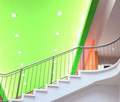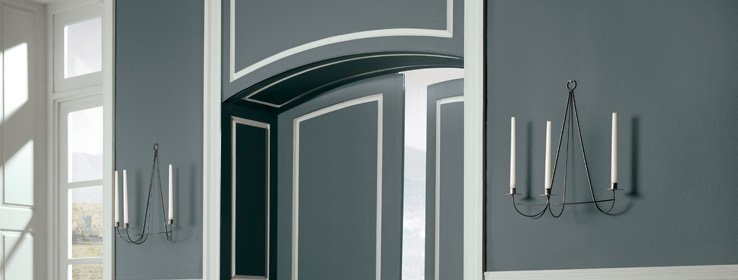Using studies of human psychology and visual perception in his defense, Phillip counters the misconception that light colors make a room feel bigger.

Some of the most powerful design lessons can't be taught in school. I remember, back when I was a young architecture student, walking into a small Tudor stucco house in St. Paul, Minn., that a classmate had been renovating, and being awestruck by the living room ceiling. No fancy tracery or pendant lights – just a flat sheet of plaster trimmed in glossy white cove molding and painted a saturated, penetrating periwinkle blue. Still a design naïf, and a product of Midwestern split-level society, I had honestly never met a ceiling not painted white, covered in knotty pine or encrusted with cottage cheese crystals. I marveled at my host's temerity. Color on a ceiling – fantastic!
Since that time, I can't help but walk into a home with all white ceilings and quietly lament the missed opportunities. And while I appreciate a white on white on white interior for its minimal purity, I've often felt architects and designers too often forgo color out of fear or lack of imagination, rather than in pursuit of an aesthetic principle.
Thanks to an explosion of free DIY advice circulating on the Internet, we can now add "misinformation" to the list of reasons people avoid rich or deep colors in architectural interiors. The recommendation goes something like this: To make a room "feel bigger," paint it a light color. Occasionally, this dictum will be supplemented by the corollary: "Warm colors will make a room feel smaller and cool colors will make it seem larger."
Two things concern me about these statements. First, there is no scientific paper or study suggesting either of these statements to be true. Second, scientific studies conducted during the last one hundred years shows the opposite to be true.
Psychological studies on human perception and distance (the earliest study I found dates to 1898) have consistently found that observers perceive bright objects to be nearer than the same objects in darker colors. Additionally, bright objects appear larger than dark objects. In design textbooks, this finding has been converted into the mantra "light colors advance and dark colors recede." [see Light: The Shape of Space, Designing with Space and Light by Lou Michel. (John Wiley and Sons, Inc., 1996) or Color in Three Dimensional Design by Jeanne Kopacz. (McGraw Hill, 2004)].
Applying this principle to an interior space, light colored walls (let's call them white) would seem to be closer to a person standing in the room and dark colored walls (let's call them gray) would seem to be farther away. Now, if I'm in a room and all the walls seem to be closer to me, I would say that makes the room "feel" smaller. Accordingly, the gray walls would seem to be farther away, giving the impression of more space between myself and the walls – to wit: a bigger room.
In the interest of fairness, it needs to be admitted that although my investigation failed to uncover any proof of the "light walls make rooms big" theory, there is an equal dearth of material proving the "dark walls make rooms big" counter theory. The only study that comes close to research on the topic was performed by a couple of psychologists (Oberfeld and Hecht) at Johannes Gutenberg University in Mainz, Germany and focused on the perception of room height related to ceiling and wall color. Published in the Quarterly Journal of Experimental Psychology in 2010, the research (using virtual reality apparatus) offered some support to the "light equals height" position, yet the findings were mixed and, to my mind, inconclusive. While observers reported that the room painted a light color seemed the tallest, the room painted a dark color appeared taller than a room painted a medium color. Go figure.
Perhaps more telling was the minor variation that color had in the perception of space, according to their paper. While the room's actual height was 10 feet, perceptual change, based on color, varied just two inches from one color to another. In fact, removing color as a variable, people overestimated the ceiling height by an average of eight inches. Even if the perceptual change is real (one way or another) it would still remain an open case of how significant the color effect would be in relation to other design decisions – let alone human fallibility in gauging distances. Do windows make a space feel bigger or smaller? How about other openings like doorways and cased openings? What about trim shape, size and gloss? Do patterns on walls have an impact? How about lines of sight to other spaces, which Frank Lloyd Wright used in numerous Prairie Style and Usonian house plans to expand the sense of spaciousness?
The Minneapolis-based residential architect Tom Whitcomb is well-known for his brazen embrace of color in his work (20 years ago he painted his own rambler-style house purple). When I recently asked him on which side of the color and room-size debate he stands, he confessed that it had never crossed his mind. "It sounds like marketing lingo more than a real design insight," Whitcomb explains. "Design rules of thumb like that don't translate well into the real world. Things are rarely so simplistic."
What's your take on color and the visual perception of space?
I agree with Tom. The point of generic rules (and of scientific studies) is to eliminate or disregard a lot of complicated reality in order to find a black or white answer. Of all the design considerations that an architect puts into a project, it would be a shame to think that making a room look a couple of inches bigger would ever be a driving issue.
I've been in a lot of living rooms since my college days – many of them much larger, brighter, more open and airier than the one in my friend's St. Paul Tudor house. But that is the one that stands out in my memory – the white room with glossy trim and a periwinkle ceiling.





